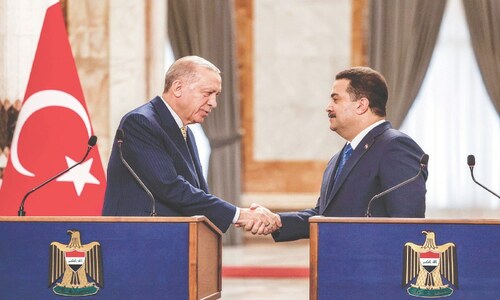LONDON: As aid pours into Afghanistan, a special consignment from India is probably bringing more happiness to Kabul than the rest of the world’s cargo combined. Low-tech, cheap and rubbery it may be, but it will transform the lives of Afghans who, after two decades of war, have had one or both legs blown off by landmines. The consignment consists of 1,000 pieces of the Jaipur foot, a prosthesis named after the city where it was developed in 1970. It was taken on a special Indian air force plane to Kabul earlier this month.
As goodwill gestures go, it has probably earned India more appreciation than any amount of diplomacy. News that the Jaipur foot was coming to town, broadcast on radio and television, prompted desperate amputees on crutches to lay siege to the newly opened Indian embassy. “Thousands of Afghans applied for it. I was taken aback at the tremendous response,” says SK Lambah, the special envoy sent to Afghanistan recently by India.
Along with the consignment went a team from Bhagwan Mahaveer Viklang Sahayata Samiti (BMVSS), a Jaipur charity that provides artificial legs for the poor. Of the 18 technicians, half are amputees themselves. The team has set up camp inside a disused building in the grounds of Kabul’s main army hospital. “Despite difficult living conditions in Kabul, when we told our people that the ministry of external affairs wanted to send a team, we had queues of enthusiastic volunteers because they know how rewarding it’s been in the past,” says SR Mehta, BMVSS’s secretary.
The Jaipur foot is a household name among people who live in the world’s many war zones. From Afghanistan to Angola, the below-the-knee limb is famous for transforming the lives of millions of landmine amputees. Lightness and mobility are its most attractive features. Those who wear it can run, climb trees and ride bicycles, all at the affordable price of $28.60.
The beauty of the Jaipur foot lies in several factors apart from the price: it takes only 45 minutes to build and a few hours to fit on to the patient, and lasts more than five years. Made largely of rubber, wood and aluminium, it can be assembled with local materials. Finally, it is perfectly suited to the lifestyle needs of countries such as India and Afghanistan, where people sit, eat, sleep and pray on the floor.
The earlier cultural mismatch with western artificial limbs was acute. They were simply too expensive for the common man, prevented squatting or cross-legged sitting, and came with an attached “shoe”, unsuitable for the rural poor, who often do not wear shoes. Even if the rural poor have shoes, they would not wear them in the fields when they are up to their ankles in mud.
The limb was first used in Afghanistan following the Soviet invasion of 1979, when Russian landmines caused thousands of injuries. Afghanistan has the highest number of amputees in the world. In fact, this is BMVSS’s third trip. It sent a team in 1996 to fit more than 1,000 limbs and it was during this visit that the International Committee of the Red Cross decided that the Jaipur foot was the best limb for the mountainous Afghan terrain. Since then, countless amputees have been fitted with the limb all over the world. A second team went to Mazar-i-Sharif in 1997, but it had to be airlifted to Uzbekistan suddenly after fitting only 200 limbs because of an impending Taliban attack.
“The Jaipur foot has been absolutely fantastic,” says Azad Singh Tour, India’s charge d’affaires in Kabul. “News spread by word of mouth that it was coming. Amputees who are having it fitted for a second time because the earlier one has worn out say it’s even lighter than before.” Tour says amputees were coming from all over Afghanistan and the team members “are working all hours of the day because they’re living in the hospital compound and so are not doing anything else except fitting the limb”.
The inventors - an orthopaedic surgeon trained in India and the UK, Dr Pramod Karan Sethi, and a semiliterate craftsman, Ram Chandra, came together 30 years ago to craft the limb. Initially, they made one horrendous mistake after another, conducting experiments with willow, sponges and aluminium moulds, interspersed with mini-tutorials from Dr Sethi explaining the anatomy of the human foot to Chandra.
One of many eureka moments came one day when Chandra had a flat tyre while riding his bicycle. According to Chandra, he went to a roadside stall whose owner happened to be retreading a tyre with vulcanised rubber. Once his bicycle was fixed, Chandra rushed to Dr Sethi for consultations on how this method could be used for a limb. Later he returned to the tyre shop, accompanied by an amputee and a foot cast, and asked the owner to make a rubber foot. It worked beautifully, although it had to undergo numerous refinements.
The team in Kabul plans to fit 1,000 limbs by the end of January. Mehta has not been to Kabul, but he has seen plenty of Indian amputees who have had their legs amputated after car accidents or other injuries and witnessed the transformation after their visit to Jaipur.—Dawn/The Guardian News Service.













































Dear visitor, the comments section is undergoing an overhaul and will return soon.